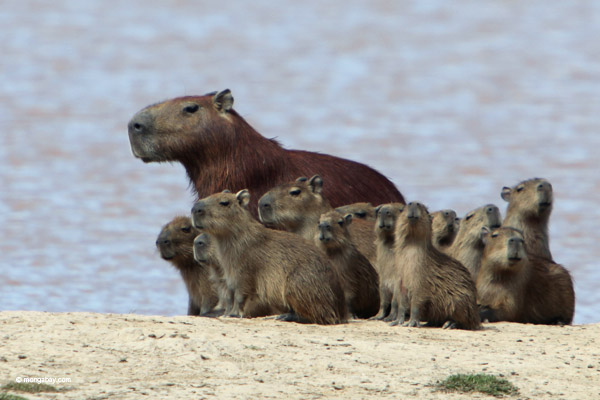
Capybaras, here in Colombia, are the world’s largest rodents today. But even they would have been dwarfed by Josephoartigasia monesi. Photo by: Rhett A. Butler.
The world’s largest rodent today is the capybara (Hydrochoerus hydrochaeris), weighing in at around at about 45 kilograms (100 pounds), though the record breaking female weighs in at 91 kilograms (201 pounds). But that’s nothing compared to the biggest rodent ever to live. Discovered in Uruguay in 2008, Josephoartigasia monesi may have weighed in at 1,000 kilograms (2,200 pounds) would have been more than 20 times bigger than a capybara and 3,000 times bigger than a really big black rat. Comparatively speaking, Josephoartigasia monesi would have been about the size of a bison.
But how did this mega-rodent behave? New research in the Journal of Anatomy suggests Josephoartigasia monesi may have used its teeth like an elephant uses its tusks. The researchers from University of York and The Hull York Medical School (HYMS) employed computer modelling and a CT scan of the skull to estimate the bite force of the giant rodent’s teeth.
“Josephoartigasia monesi had a bite of 1389 N at the incisors, rising to 4165 N at the third molar,” the researchers write. The N refers to a “newton,” or standardized measurement of force. Josephoartigasia monesi‘s bite force is around that of a tiger’s; in contrast, human bite force is about 720 N.
Most notably, though, the researchers found that the teeth were structured so they could handle much more stress than they applied.
“The incisors of Josephoartigasia monesi were overengineered with respect to feeding; that is, they could resist much greater forces than could ever be generated by the masticatory muscles. Thus, it has been suggested that Josephoartigasia monesi may have regularly used its incisors for activities other than feeding, such as digging for food or defense against predators,” the researchers write.
This leads the researchers to compare the possibly feeding ecology of Josephoartigasia monesi to an elephant’s.
“That is, it could process a broad selection of tough vegetation with the short molar tooth row, while using its unusually strong incisors like tusks for defence and digging for roots,” the researchers write.
Josephoartigasia monesi, which only based on a single skull to date, lived around 2-4 million years ago. Its closest living relative is the pacarana (Dinomys branickii), also known as Count Branikii’s terrible mouse, weighing in at a still impressive 15 kilograms (33 pounds). The species listed as Vulnerable by the IUCN Red List due to habitat destruction and hunting.
Pacaranas are large, slow-moving, nocturnal rodents that inhabit the forests of northern and central Bolivia. The species is listed as Vulnerable by the IUCN, and is the sole member of the Dinomyidae family. Photo by Benjamin Frable.
Citations:
- Cox, Philip G., Andrés Rinderknecht, and R. Ernesto Blanco. “Predicting bite force and cranial biomechanics in the largest fossil rodent using finite element analysis.” Journal of anatomy (2015).
Related articles
|
It only took 2,500 people to kill off the world’s biggest birds (11/10/2014) The first settlers of New Zealand killed off nine species of giant birds, known as moas, with a population no bigger than a few thousand people, according to new research published in Nature Communications. The biggest moas stood up to 3.6 meters (12 feet) tall, making these mega-birds the largest animals in the country and contenders for the biggest birds ever. |
|
A garden or a wilderness? One-fifth of the Amazon may have been savannah before the arrival of Europeans (07/09/2014) The Amazon is the largest tropical forest on the planet, covering about 6.5 million square kilometers, although much has been lost in recent decades.Yet new research published in the Proceedings of the National Academy of Sciences (PNAS) finds that quite recently—just 500 years ago—a significant portion of the southern Amazon was not the tall-canopied forest it is today, but savannah. |
|
Blame humans: new research proves people killed off New Zealand’s giant birds (03/17/2014) Moas were a diverse group of flightless birds that ruled over New Zealand up to the arrival of humans, the biggest of these mega-birds stood around 3.5 meters (12 feet) with outstretched neck. While the whole moa family—comprised of nine species—vanished shortly after the arrival of people on New Zealand in the 13th Century, scientists have long debated why the big birds went extinct. Some theories contend that the birds were already in decline due to environmental changes or volcanic activity before humans first stepped on New Zealand’s beaches. But a study released today in the Proceedings of the National Academy of Sciences (PNAS) finds no evidence of said decline, instead pointing the finger squarely at us. |
|
Giant turtle-devouring duck-billed platypus discovered (11/04/2013) Based on a single tooth from Australia, scientists believe they have discovered a giant, meter-long (3.3 feet) duck-billed platypus that likely fed on fish, frogs, and even turtles, according to a new study in Journal of Vertebrate Paleontology. At least twice the size of a modern duckbilled platypus, the scientists say the extinct giant likely lived between 15 and 5 million years ago. |
|
Nutrient deficiency in Amazon rainforest linked to megafauna extinction (08/12/2013) Around twelve thousand of years ago, the Amazon was home to a menagerie of giant creatures: the heavily armored glyptodons, the elephant-sized ground sloth, and the rhino-like toxodons among others. But by 10,000 B.C. these monsters were largely gone, possibly due to overhunting by humans or climatic changes. There’s no question that the rapid extinction of these megafauna changed the environment, but a new study in Nature Geoscience posits a novel theory: did the mass extinction of big mammals lead to nutrient deficiency, especially of nitrogen, in parts of the Amazon rainforest? |
|
Giant prehistoric freshwater turtle discovered (05/18/2012) Researchers working in Colombia has discovered the fossilized remains of a giant freshwater turtle that lived some 60 million years ago. |





.150.jpg)